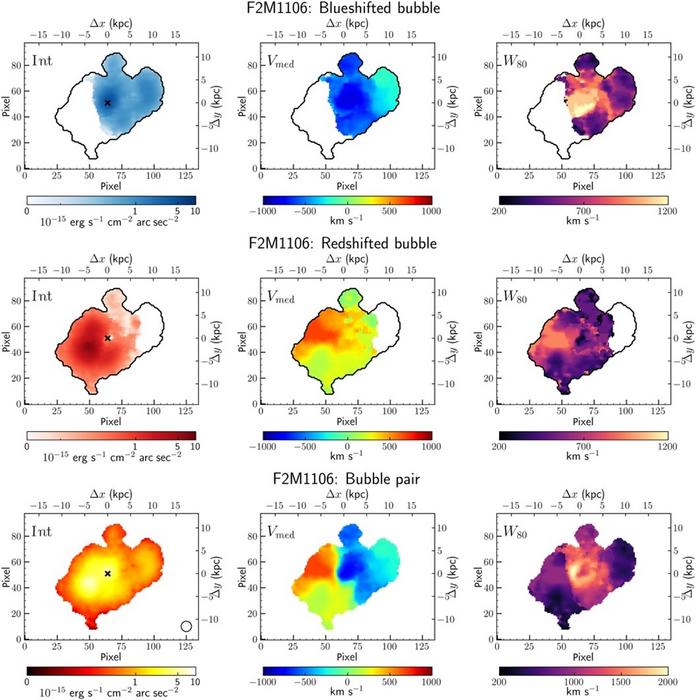| Aug 11, 2023 |
Astronomers discover quasar-driven superbubble pairs
|
|
(Nanowerk News) A team led by Prof. LIU Guilin and Prof. HE Zhicheng from the University of Science and Technology of China (USTC) of the Chinese Academy of Sciences (CAS) discovered superbubble pairs generated by quasar-driven outflows of three red quasars for the first time.
|
|
This study was published in Science Advances ("Discovery of spectacular quasar-driven superbubbles in red quasars").
|
|
The observed number of massive galaxies is significantly lower than the prediction of the current galaxy evolution theory, thus certain mechanism is needed to suppress star formation and modulate the growth of the galaxy. To bridge the gap between theory and observation, an outflow mechanism where a galaxy nucleus drives a massive amount of gas into intergalactic space at its rather active quasar stage was proposed to be a crucial part of the galaxy evolution model. However, the outflow mechanism remained a theoretical assumption due to limitations in actual observations.
|
 |
| The surface brightness, line-of-sight velocity, and velocity dispersion maps of superbubble pairs. (Image: SHEN Lu et al.)
|
|
Previous research by Prof. LIU’s team discovered direct evidence of quasi-spherical outflows in highly luminous quasars at intermediate redshift. Red quasars are likely to drive energetic outflows as the most luminous quasars at every epoch. Traditional quasar selection method tends to leave out red quasars due to their faintness in optical bands. Given this, the team used the Gemini-North Multi-Object Spectrographs to compensate for the observations on red quasars and found that half of the sample galaxies feature significant outflows.
|
|
Unlike previously discovered quasi-spherical outflows, these outflows exhibited forms of spectacular superbubble pairs. The biggest pair extended more than 60 000 lightyears in diameter and reached a maximum line-of-sight velocity of 1200 km s-1. These superbubble pairs, generated by quasar-driven outflows impacting the galactic gas, are at a short-lived “break-out” phase when they escape from the dense environment of the galactic nucleus and plunge into the galactic halo. The team also performed numerical simulations and found that the energy of the outflow gas could have a significant effect on the galaxy's evolution.
|
|
The discovery of superbubble pairs is of great value to the research on the outflow mechanism. Firstly, the existence of superbubble pairs is fairly solid evidence for outflow, whereas previous observations based solely on line-of-sight velocity field tended to confuse outflows with inflows, making it difficult to reliably identify outflows. Moreover, superbubble pairs provide a unique opportunity to calculate the outflow energy and evaluate the effect of outflows on the overall evolution of the galaxy.
|
|
Although there have been some precedents for superbubble structures, this work is the first systematic discovery of superbubble structures in a specific type of galaxy. The team has completed the first systematic survey of highly luminous quasars at intermediate redshift using the integral field spectrograph, which is expected to have a profound impact on the construction of the galaxy evolution paradigm.
|

